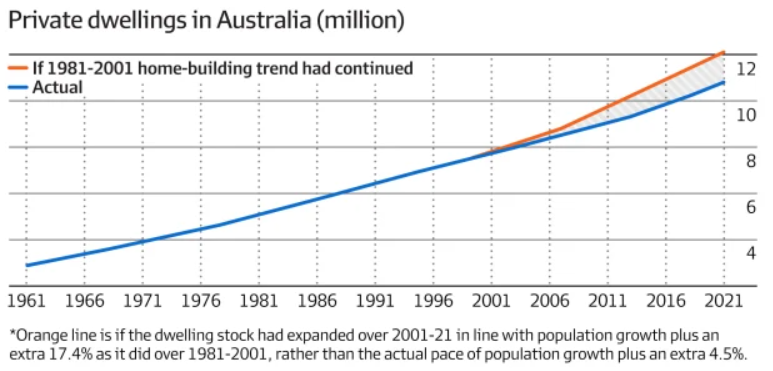A few days ago, LVO took former RBA economist, Tony Richards to task for his biased take on the housing crisis.
Richard’s argument was as follows.
“For many decades following the Second World War, the percentage growth in the number of homes was well in excess of the growth in the Australian population”.
“At the 1981 census, the total number of private dwellings was 22% higher than would have been implied just by the growth in the population since the 1961 census”.
“In the 20 years to 2001, growth in the number of dwellings was 17% higher”.
“But around the start of this century that changed. In the 20 years to 2021, the percentage growth in the number of dwellings was only slightly faster (by 4.5%) than the growth in the Australian population, and the long-term downward trend in the average household size largely stopped”.
“If the relationship between the growth in the population and the housing stock seen in the 20 years to 2001 had been maintained over the 20 years to 2021, Australia would have had around 1.3 million more dwellings than the 10.85 million dwellings reported in the 2021 census”.

Source: Dr Tony Richards (via The AFR)
Aside from the fact that a ratio is an artificial measure that fails to take into account that the absolute numbers in the real world are much higher with obvious implications for resource limitation, MB reader Burbwatcher slayed this eggheaded rubbish with the simplest statement on this issue I can recall:
Let’s not discuss the relative elasticity of Demand vs Supply.
That’s the lie in this issue in a nutshell.
Housing demand is very elastic. It can be raised or lowered with the stroke of a pen via immigration numbers.
Housing supply is very inelastic. Australia has far more homes than the OECD average but it is never enough because, by nature, the supply response is inelastic owing to:
- finding a property
- raising debt
- approvals lead times
- construction lead times.
So, if you are genuinely concerned about a housing rental and price crisis then literally the only solution is to reform the elastic demand side of the equation.
This points to the maddening truth that nobody is genuine about their concern.

